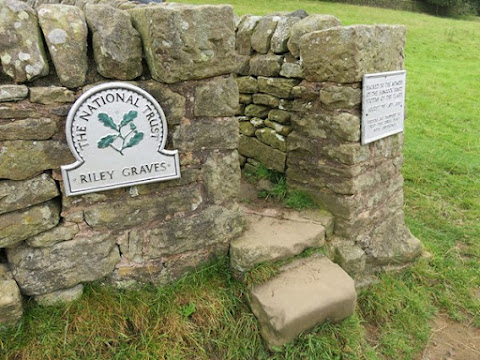Eyam is famous because as villagers began to die, the new rector, William Mompesson, and the former Puritan minister, Thomas Stanley, worked together to slow its spread and keep the plague contained to the village. (This was right after the restoration of the monarchy, and so the Puritan minister who would have been installed by Oliver Cromwell's government was removed, but the villagers liked him and encouraged him to continue to live there.)
Mompesson had lived in a village with an outbreak of the plague about 20 years previously, so he knew the plague and how to deal with it, and meanwhile the people trusted Stanley. So the clergymen worked together to move church services to a natural amphitheater nearby, ordered that families were to bury their own dead (in their gardens or on common parish land, not in the churchyard), and instituted a quarantine for the entire village. Some did get around the quarantine, escaping the village and in some instances heading to the hills, and at the beginning of the outbreak Mompesson sent his own children away and tried to send his wife away as well, but she would not go; she wanted to stay and help the village.
Food was left for them outside the village, much of it provided by the then Earl of Devonshire, for Chatsworth is not far away. Since the rich had got out of dodge, it was basically the poor who remained, and it was said they actually ate better during the plague than they had beforehand. They paid for food and medicine by leaving coins that had been soaked in vinegar on the boundary stone.
Some who didn't have enough money to get completely away still went up into the hills to try to scratch out a living there. It didn't work for the Hancock family, most of whom are buried in what are today called the Riley graves (the land belonged to the Rileys). Poor Elizabeth Hancock had to bury her husband and six children there, but she survived.
Back to Eyam, however: they did a study analyzing the DNA of village families that went back to the time of the plague and found that a high proportion of the villagers had the Delta32 mutation. There is also a theory that its benefits regarding the plague get activated during childbirth, which is why so many mothers survived.
Sadly, Catherine Mompesson was not one of them. One evening in the midst of all their work to help the villagers, she told her husband they should do something nice for themselves that evening, just the two of them, and so they went for a walk. As they were walking back home, though, she said, "Doesn't the air smell sweet tonight?" And Rev. Mompesson knew then that his wife had the plague, because one of the symptoms was that it messed up your sense of smell. She died, and was the only person who was allowed to be buried within the churchyard because the villagers wanted to honor her for all she had done to help them.
The plague ran for 14 months. The total number of villagers who died has mixed reports, but it was in the hundreds. The town succeeded, though, in their quarantine, and so there was no spread of the plague elsewhere in Derbyshire.
If ever you have a chance to go to Eyam, I recommend it, and particularly taking one of the National Trust tours. They are filled with sad stories, but poignant ones, of this town that quarantined themselves so others could live. You can also tour Eyam Hall, built by a prosperous family in post-plague times (you might recall it from a previous post of mine). Like so much of Derbyshire, the views are lovely as well, although it was quite foggy when I went. The guide said on a clear day, you can see Chatsworth. The actions of these villagers might very well have saved it, too.And I hope you all are staying safe and healthy. I'll be back next month with my planned tour of another country house, for I'm sure we'll all be ready for more armchair travel by then.









.jpg)

No comments:
Post a Comment